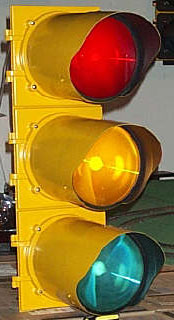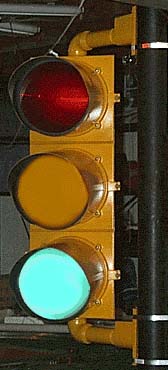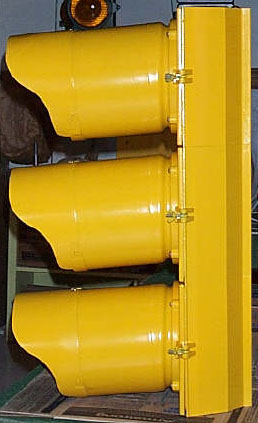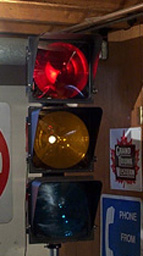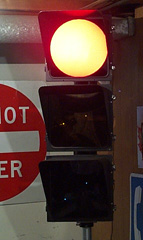3M Programmable Visibility Traffic Signals
This page features 3M vehicle and pedestrian signals.
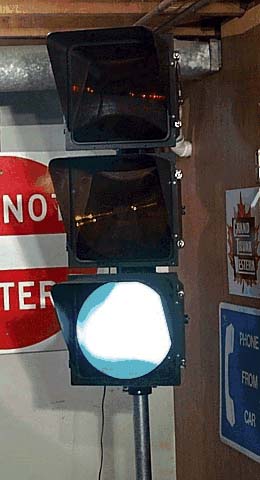
|
The pictures to the left and right can be animated by placing
your mouse over the picture. The colors of the three indications in the animations on
this page are distorted due to the fact that animated gifs are only made in 256 colors rather than millions of colors like in JPEG and BMP files.
Here are some very interesting signals. These signals are unlike most common signals because in common signals, the light bulb is directly behind the colored lens and has a reflector directly behind the bulb. The 12 inch 3M signals do not use a reflector. The light bulb in the 12 inch 3M vehicle signal is a powerful 150 watt bulb that looks some what like the old round car headlights from years ago. The pedestrian signals use 75 watt bulbs of the same type. |
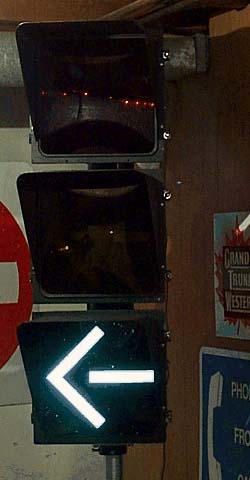
|
You can view an animation of the pedestrian signal on the
written
command pedestrian signal page.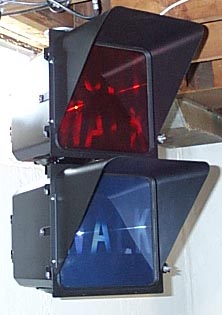
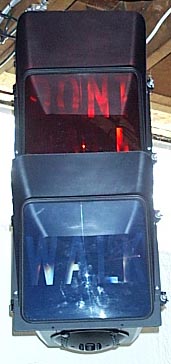
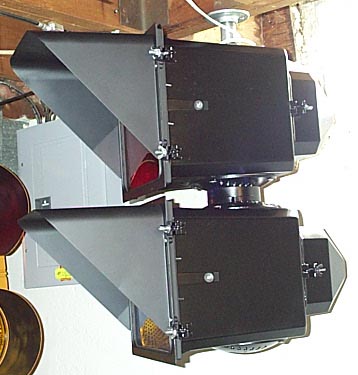
|
Here is another 3M product. It is an 8 inch to 12 inch enlarging unit. With this attachment, the normal lens is replaced with a frosted lens of the same color and the enlarging unit is mounted in place of the standard visor. Below you can see the individual parts of this unit. The frame that holds the lens just slides upwards to come off the piece that is mounted to the signal door. Then the lens just slides out of the frame. The signal this unit is mounted to is a Marbelite. |
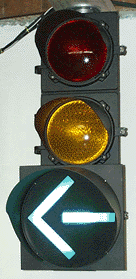 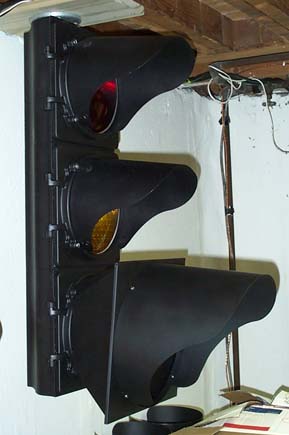 |
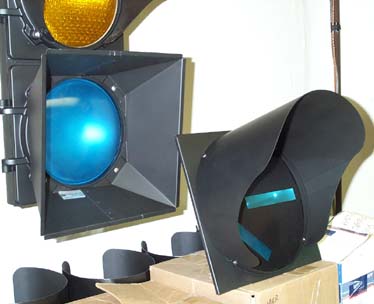
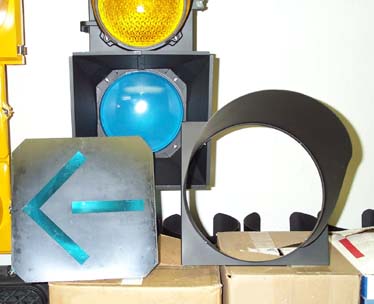
Here are the light bulbs that are used in the 12 inch 3M signals.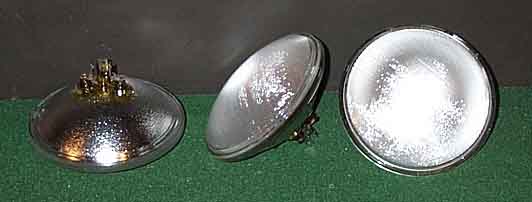
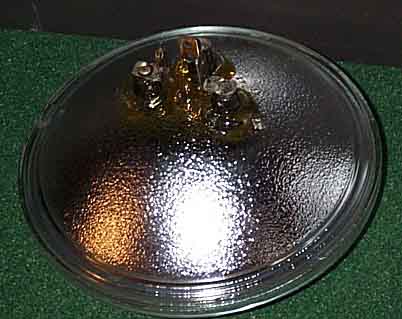
The light bulb is mounted in the back door of the signal, shown open in the pictures below. The light is directed thru a light diffuser which has a frosted appearance as shown in the first picture below and then thru an optical limiter shown in the next picture (the diffuser is removed in that picture) and then out the front colored lens.
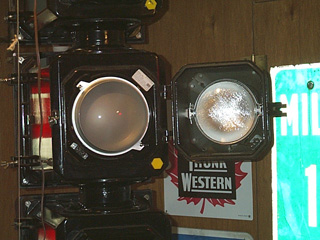
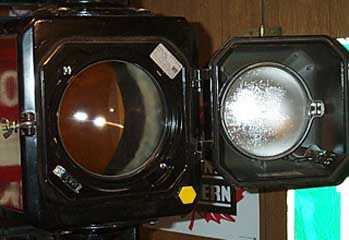
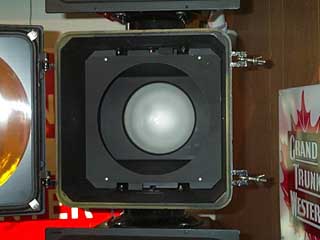 |
The 3M adapters for 8 inch signals are fairly obsolete. The date on one of the lenses of my Econolite-3M signal is 1969. Since standard 12 inch signals are steadily replacing standard 8 inch signals, it makes sense that the 3M adapters for 8 inch signals are out dated. The 3M adapters also use a light diffuser like the 12 inch 3M signal, but there isn't a clear lens called the optical limiter that is present in the 12 inch signal. 8 inch adapters can be masked just like the 12 inch signals, but the masking is done directly on the light diffuser unlike the 12 inch signal where the masking is applied to the clear optical limiter and the light diffuser is mounted on top of that. Below are two pictures of the 8 inch adapter from the inside and from the front with the lens removed.
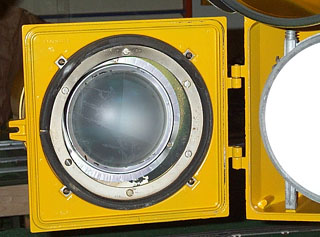
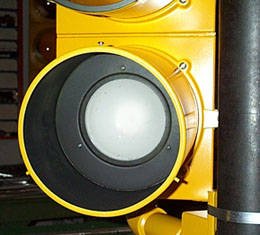
The 3M Programmable Visibility or High Visibility Signal has brighter indications than standard incandescent signals because the light diffuser and special colored lenses on the front act like a projector which produces higher visibility and a brighter indication. But there is another feature of this signal, called Programmable Visibility. What this means is the signal can be installed and "masked" so that only certain lanes of traffic get a clear indication and other lanes controlled by a second signal do not see the indication for the lanes the first signal is controlling. Special tape is installed on the optical limiter from the back of the signal. This tape is silver on the side facing the light bulb and black on the opposite side. Below are two pictures of the red section on my 3M light that I have masked. I do not have the special silver and black tape, so I improvised and put black electrical tape down first and then silver tape on top of that. 3M recommends that there be NO wrinkles in the tape when correctly installed. As you can see, my installation of the tape was far from perfect, but it was adequate to demonstrate how this "masking" works to "hide" the signal indications from certain angles.
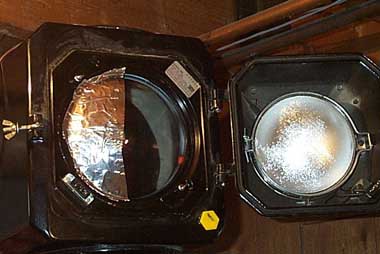
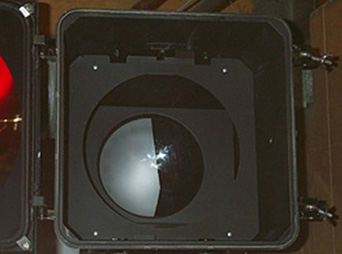
I have masked the red indication of this signal so that if it were in use on a street, traffic directly in front of or to the right of this signal would get a clear red indication but traffic in a lane to the left of the signal would not get a clear indication. Because the lighting in my basement is much darker than outside on a sunny day, you can still tell that the red light is on even when standing in the masked area of projection but it is noticeably faint when compared to when standing in the unmasked area of projection. On a bright sunny day, the red indication would be extremely hard to see when in the masked area of projection.
|
|
|
This page was originally posted on 2/4/2001.
